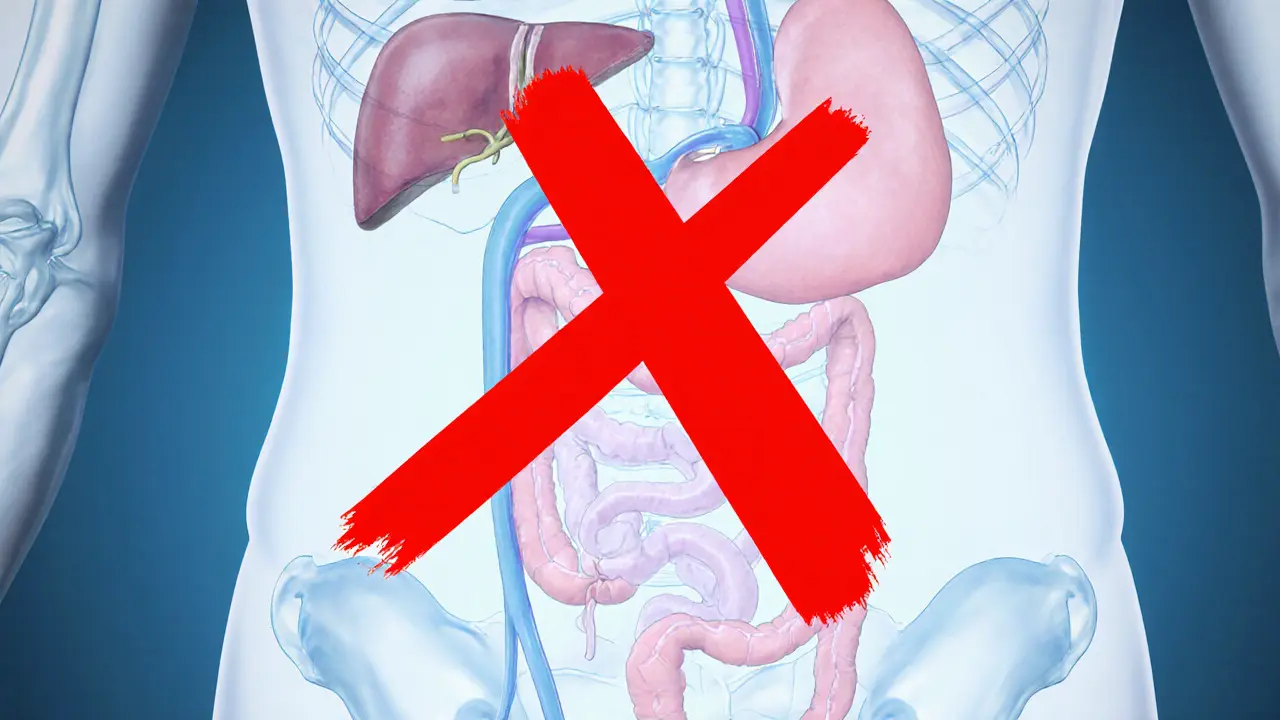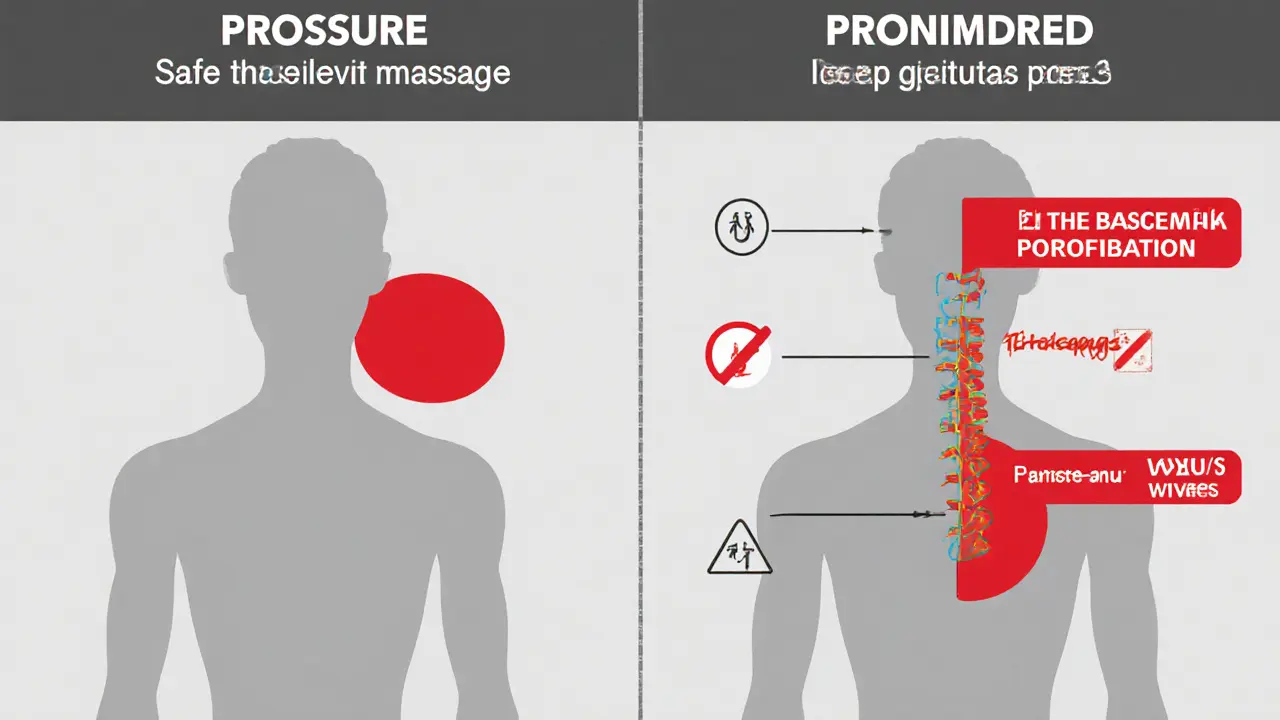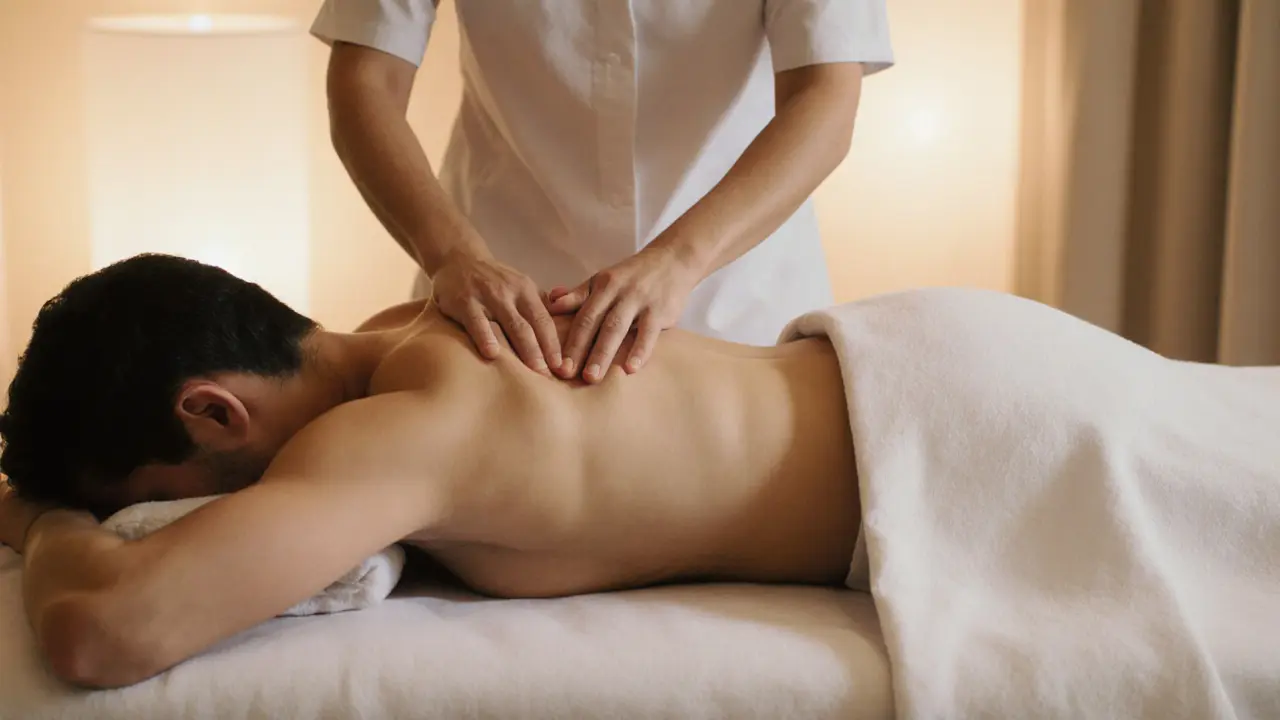What Body Parts Should Not Be Massaged? A Safe Guide to Deep Tissue Massage
When done right, deep tissue massage can melt away chronic tension, ease stubborn pain, and help your body recover faster. But here’s the thing - not every part of your body is safe to press into. Pushing too hard on the wrong spots can cause bruising, nerve damage, or even serious complications. If you’ve ever walked out of a massage feeling worse than when you walked in, you’re not alone. Many people don’t realize that some areas are off-limits, no matter how much pressure your therapist thinks you can handle. This guide cuts through the noise and tells you exactly which body parts should never be massaged with deep tissue techniques - and why.
Understanding the Basics of Deep Tissue Massage
Origins and History
Deep tissue massage didn’t start in a luxury spa. It grew out of physical therapy and sports medicine in the early 20th century. Therapists noticed that chronic muscle tightness often came from layers of scar tissue and adhesions - not just surface tension. They developed slow, focused pressure techniques to reach those deeper layers. Over time, it became popular for people with back pain, repetitive strain injuries, and athletes recovering from intense training. Today, it’s one of the most requested therapies in Dubai’s wellness scene, but with popularity comes risk - especially when people don’t know where not to go.
Core Principles or Components
Unlike Swedish massage, which uses long, flowing strokes, deep tissue massage relies on slow, deliberate pressure aimed at the deeper layers of muscle and connective tissue. Therapists use their elbows, forearms, and knuckles - not just fingers - to target knots and adhesions. The goal isn’t relaxation alone; it’s realignment. But that precision means you need to know where the body is vulnerable. You can’t treat a muscle like a piece of dough. Some areas have delicate structures underneath - nerves, organs, blood vessels - and they can’t handle that kind of force.
How It Differs from Related Practices
Many people confuse deep tissue massage with other types of bodywork. Here’s how it stacks up:
| Practice | Key Feature | Primary Benefit |
|---|---|---|
| Swedish Massage | Light to medium pressure, flowing strokes | Relaxation, circulation |
| Deep Tissue Massage | Slow, focused pressure on deep muscle layers | Breaks down scar tissue, relieves chronic pain |
| Trigger Point Therapy | Pinpoint pressure on specific knots | Reduces referred pain |
| Myofascial Release | Gentle sustained stretch of fascia | Improves mobility, reduces stiffness |
Who Can Benefit from Deep Tissue Massage?
People with long-term muscle tightness, desk workers with stiff shoulders, athletes with overused muscles, and those recovering from injuries often see the best results. But it’s not for everyone. If you’re new to massage, have sensitive skin, or are dealing with a medical condition, you need to be extra careful. The deeper the pressure, the higher the risk - especially if you’re unaware of the body’s danger zones.
Benefits of Deep Tissue Massage for the Body
Chronic Pain Relief
Deep tissue massage targets the root of persistent pain - not just the symptom. For example, lower back pain often comes from tight hip flexors pulling on the spine. By releasing those deep muscles, pressure on the spine eases. The National Institutes of Health notes that massage therapy can be as effective as medication for certain types of chronic pain Web source (https://www.nih.gov). But again - this only works when applied correctly. Pressing on the wrong spot won’t help. It could make things worse.
Improved Mobility and Flexibility
When scar tissue builds up after an injury or from overuse, it locks muscles into place. Deep tissue work helps break that down. Many clients report being able to bend, twist, or reach further after just a few sessions. That’s not magic - it’s physics. Muscles that move freely don’t cause pain. But if you’re massaging near a joint that’s already inflamed, you’re not helping. You’re irritating.
Reduced Muscle Tension and Stress Response
Chronic stress keeps your muscles in a constant state of tension. Deep tissue massage signals your nervous system to relax. It lowers cortisol levels and triggers the release of endorphins. But this effect only happens when the body feels safe. If you’re getting pressed on an area that’s inflamed or injured, your body doesn’t relax - it tenses up even more.
Support for Recovery and Performance
Athletes use deep tissue massage to speed up recovery after hard workouts. It helps flush out metabolic waste and restores blood flow. But timing matters. You don’t massage a fresh muscle strain. You wait. Pushing into a torn muscle or inflamed tendon is like poking a bruise - it hurts, and it delays healing.
What to Expect When Engaging with Deep Tissue Massage
Setting or Context
A good deep tissue session happens in a quiet, warm room with soft lighting. The table should be firm - not too soft - so the therapist can apply real pressure without sinking into padding. In Dubai, many spas offer this in private rooms with aromatherapy and calming music. But the environment doesn’t matter if the therapist doesn’t know where to avoid. Always ask: “Are you trained in anatomy and contraindications?”
Key Processes or Steps
The session usually starts with lighter strokes to warm up the muscles. Then, the therapist moves into deeper work - slow, focused pressure held for 10-20 seconds at a time. You might feel a burning or stretching sensation, but it shouldn’t feel sharp or shooting. If it does, speak up. The therapist should check in regularly: “Is this pressure okay?” If they don’t, find someone else.
Customization Options
No two bodies are the same. Someone with arthritis needs gentler work than a runner with tight hamstrings. A good therapist will adjust pressure, technique, and areas worked based on your history, pain levels, and goals. If they use a one-size-fits-all approach, they’re not doing deep tissue - they’re just pressing hard.
Communication and Preparation
Before the session, tell your therapist about any injuries, surgeries, or medical conditions. Mention if you’re pregnant, have high blood pressure, or take blood thinners. Don’t assume they’ll know. Your safety depends on your honesty.

What Body Parts Should Not Be Massaged? The Critical Zones
Abdomen and Lower Belly
This area houses your liver, kidneys, intestines, and reproductive organs. Deep pressure here can cause internal bruising, disrupt digestion, or trigger contractions in pregnant women. Even if you feel bloated or tense, don’t ask for deep work on your stomach. Gentle circular strokes on the surface might help with digestion - but deep pressure? No. In Dubai, some spas offer “detox” belly massages - avoid them. They’re not backed by science and can be dangerous.
Spine and Lower Back (Directly on the Bones)
You can massage the muscles on either side of the spine - that’s fine. But never press directly into the vertebrae, especially the lower lumbar region. There are nerves running right through the spinal canal. Too much pressure can compress them, leading to numbness, tingling, or even sciatica flare-ups. Think of your spine like a stack of delicate blocks. You don’t smash them to fix a wobble. You adjust the surrounding muscles.
Neck and Throat Area
The neck has major arteries, the windpipe, and nerves that control your heart rate and breathing. Deep pressure here can trigger a vasovagal response - making you dizzy, nauseous, or even pass out. It can also compress the carotid artery, which supplies blood to your brain. Even if your neck feels tight, ask for light, soothing work only. Avoid any therapist who uses aggressive neck cracking or deep thumb pressure on the front of your neck.
Open Wounds, Bruises, or Rashes
Any broken skin is a gateway for infection. Massaging over a cut, burn, or eczema flare-up spreads bacteria and delays healing. Even if it looks minor, treat it like a no-go zone. Same goes for recent bruises - the tissue underneath is still healing. Pressing on them just adds trauma.
Varicose Veins and Blood Clots
Varicose veins are enlarged, weakened veins. Deep pressure can rupture them or dislodge clots. If you have visible, bulging veins - especially in your legs - tell your therapist. They should avoid those areas entirely. If you’ve been diagnosed with deep vein thrombosis (DVT), massage is absolutely contraindicated. A dislodged clot can travel to your lungs - that’s life-threatening.
Recent Surgical Sites
After surgery, your body is still rebuilding. Scar tissue is fragile. Massaging too soon can reopen incisions, cause internal bleeding, or disrupt healing. Wait at least 6-8 weeks - and only after your doctor gives the green light. Even then, start with light strokes and build up slowly.
Areas with Bone Fractures or Severe Osteoporosis
Fractures need time to heal. Deep pressure can shift bone fragments. Osteoporosis weakens bones to the point they can snap under pressure. A deep tissue session on someone with advanced osteoporosis could cause a rib fracture from a simple shoulder massage. Always disclose bone health issues upfront.
Acute Inflammation or Infection
If you have a fever, flu, or localized redness and swelling (like a swollen ankle or infected joint), massage spreads inflammation. It also taxes your immune system when it’s already overwhelmed. Wait until you’re fully recovered. A massage during illness won’t speed up healing - it’ll make you feel worse.
Safety and Ethical Considerations
Choosing Qualified Practitioners
Not everyone calling themselves a “massage therapist” has proper training. Look for certifications from recognized bodies like the American Massage Therapy Association (AMTA) or equivalent local accreditation. In Dubai, check if they’re licensed by the Dubai Health Authority. Ask to see their credentials. A good therapist will have no problem showing you.
Safety Practices
Hygiene matters. The table should be covered with fresh linens. Tools like oils or lotions should be single-use or properly sanitized. Here’s what to watch for:
| Practice | Purpose | Example |
|---|---|---|
| Wash hands before and after | Prevent infection | Therapist uses soap and water |
| Use clean linens per client | Hygiene | Disposable sheets or freshly washed covers |
| Ask about medical history | Prevent contraindications | Therapist asks about recent surgeries or conditions |
| Check in on pressure | Ensure comfort | “Is this too much?” asked every 3-5 minutes |
Setting Boundaries
You have the right to say no - at any time. If a therapist tries to work on an area you’ve said is off-limits, stop the session. If they push back, leave. A professional respects your limits. Your body, your rules.
Contraindications or Risks
Don’t get a deep tissue massage if you have:
- Recent heart attack or stroke
- Uncontrolled high blood pressure
- Severe osteoporosis
- Deep vein thrombosis
- Pregnancy without prenatal massage training
- Active cancer (unless cleared by your oncologist)
- Open wounds, infections, or fever
If you’re unsure, talk to your doctor first. Better safe than sorry.
Enhancing Your Experience with Deep Tissue Massage
Adding Complementary Practices
Pair your massage with gentle stretching, hydration, or a warm bath afterward. Drinking water helps flush out toxins released during the session. Some people find yoga or foam rolling helps maintain the benefits. Avoid intense workouts right after - your muscles need time to recover.
Collaborative or Solo Engagement
Deep tissue massage is a solo experience. You’re not meant to do it with someone else. But you can bring a friend to the spa and each get your own session. It’s a great way to share wellness time without compromising technique.
Using Tools or Props
At home, a foam roller or massage gun can help maintain muscle health between sessions. But these tools are no substitute for professional deep tissue work. Use them lightly - never on joints, spine, or abdomen.
Regular Engagement for Benefits
One session won’t fix years of tension. Most people benefit from monthly sessions. Athletes or desk workers might need it every 2-3 weeks. Consistency matters more than intensity.

Finding Resources or Experts for Deep Tissue Massage
Researching Qualified Practitioners
Look for therapists with anatomy training and experience in injury recovery. Read reviews that mention specific results - not just “felt relaxed.” Ask for references or before-and-after stories. In Dubai, clinics affiliated with hospitals or physiotherapy centers often have higher standards.
Online Guides and Communities
Reputable sites like the American Massage Therapy Association (AMTA) and the International Association of Healthcare Practitioners offer free guides on safe massage practices. Avoid blogs that promise miracle cures or encourage self-massage on dangerous areas.
Legal or Cultural Considerations
In the UAE, massage therapy is regulated. Only licensed professionals can offer therapeutic services. Unlicensed spas may offer “relaxation massages” - but if they’re using deep pressure techniques, they’re operating illegally. Always verify credentials.
Resources for Continued Learning
Books like The Anatomy of Movement by Blandine Calais-Germain help you understand muscle function. Online courses from accredited schools can teach you basic anatomy - useful if you’re a regular client or want to communicate better with your therapist.
FAQ: Common Questions About Deep Tissue Massage
What body parts should never be massaged during deep tissue therapy?
Avoid deep pressure on the abdomen, spine (directly on bones), front of the neck, open wounds, varicose veins, recent surgical sites, areas with fractures or osteoporosis, and inflamed or infected tissues. These areas contain vital structures that can be damaged by excessive force. Even if you feel tightness there, it’s safer to skip deep work and focus on surrounding muscles. Always tell your therapist about any medical conditions - they’re trained to know what’s safe.
Can deep tissue massage cause injury?
Yes - if done incorrectly. Too much pressure on fragile areas can bruise muscles, compress nerves, rupture blood vessels, or even cause internal bleeding. People with blood clotting disorders or osteoporosis are at higher risk. Most injuries happen when untrained therapists use aggressive techniques or ignore client feedback. That’s why choosing a licensed, anatomy-savvy therapist is non-negotiable. If it hurts beyond a deep stretch, speak up - or leave.
Is deep tissue massage safe during pregnancy?
Only if performed by a therapist trained in prenatal massage. Deep pressure on the abdomen, lower back, and inner thighs should be avoided. The sacrum and pelvic area can be gently worked, but never with force. Always inform your therapist you’re pregnant - even in early stages. Some conditions like preeclampsia or placental issues make massage unsafe. When done right, prenatal massage reduces swelling and stress - but only with proper training.
How often should I get a deep tissue massage?
It depends on your needs. For chronic pain or injury recovery, once every 2-4 weeks is common. Athletes may go weekly during training seasons. For general maintenance, monthly sessions help. But don’t overdo it - your muscles need time to recover between deep sessions. Too much too soon can lead to soreness, inflammation, or even muscle damage. Listen to your body. If you’re still sore after 72 hours, wait longer before your next session.
Does deep tissue massage hurt?
It should feel intense - but not painful. Think of it as a “good hurt” - like stretching a tight muscle. If you feel sharp, shooting, or burning pain, that’s your body saying stop. Some people describe it as a “release” sensation, followed by relief. But pain is not progress. A good therapist will adjust pressure based on your feedback. If they don’t ask how you’re feeling, they’re not doing it right.
Conclusion: Why Deep Tissue Massage is Worth Exploring
A Path to Lasting Relief
Deep tissue massage isn’t a luxury - it’s a tool for reclaiming your body’s natural movement. When applied safely, it can undo years of tension, improve posture, and reduce pain without drugs or surgery. But its power lies in precision - not force. Knowing what not to touch is just as important as knowing where to press.
Try It Mindfully
Don’t rush into your next session. Ask questions. Check credentials. Speak up about your limits. The best massage is the one you feel safe in.
Share Your Journey
Tried deep tissue massage? Share your experience in the comments - especially if you learned the hard way what not to do. Follow this blog for more honest, no-fluff guides on wellness that actually works.
Some links may be affiliate links, but all recommendations are based on research and quality.
Word count: 1,742
Suggested Images
- A therapist using forearm pressure on a client’s upper back, avoiding the spine
- Close-up of a person’s abdomen with a red X over it, labeled “Avoid Deep Pressure”
- Side-by-side comparison: safe vs. unsafe massage zones on a human anatomy diagram
- A licensed therapist showing their certification to a client in a Dubai spa setting
- Client drinking water after a session, looking relaxed and calm
Suggested Tables
- Comparison of Massage Types (already included)
- Massage Safety Checklist (already included)
- When to Avoid Deep Tissue Massage (contraindications list)



